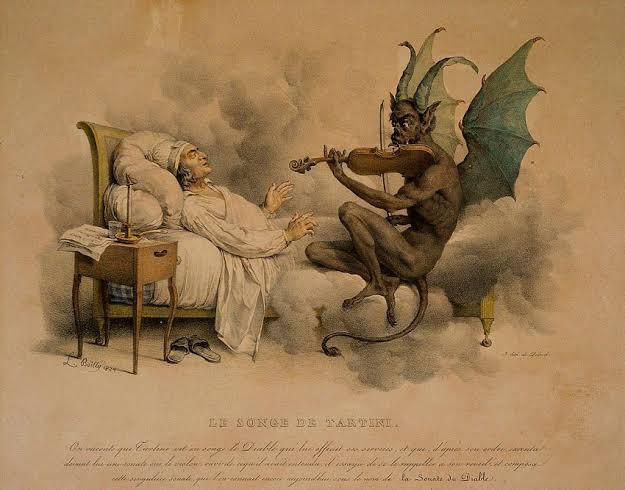
Concert Review: Metallica (January 1, 2023, Los Angeles)
18 September 2023
Review: “Pain – Coming Home”
22 November 2023Have you ever encountered melodies that disturb you, keep you from sleeping and fill you with a dark feeling? It seems unlikely that you haven’t. Nowadays, the devil’s interval has become a treasure trove of modern suspense, a staple of many metal bands as well as horror movies. Associated with the devil due to the feeling of uneasiness it gives off, this interval is a frequently preferred motif, especially in heavy metal bands like Slayer and Black Sabbath.
The devil’s interval, also known as the tritone, has a long history in music history. It appears everywhere from the Middle Ages to the Renaissance, and from the Renaissance to the modern century. The word “tritone” is etymologically derived from the Latin and Greek words “tri” meaning “three” and “tone” meaning “sound”. Triton was also called the devil in music in the Middle Ages. So what is so terrible that it is called “Diabolus in Musica”?
First, let’s analyze the triton technically. The tritone is divided into two types: horizontal and vertical. Horizontal tritone, also known as melodic tritone, refers to the tritone interval between consecutive notes in a melody. A consecutive melody created from C to F sharp is a horizontal tritone. Vertical tritone, also known as harmonic tritone, refers to the tritone interval between multiple notes played at the same time. Here, a chord containing C and F sharps is shown as an example of a vertical tritone. Another example of a vertical tritone can be given in the key of C major, where the notes B and A played together form the devil’s interval.
There are different theories as to why the tritone creates so much tension and has such a disturbing effect. These theories and studies are mainly based on the concept of ‘harmony’. Harmony is a theme related to the human search for order and harmony, and this idea has been emphasized by many philosophers. Plato says that the lack of harmony between the three parts of the soul will lead to conflict. We also observe that he emphasizes the search for inner order and harmony in his work “The State (Politeia)”. Although the harmony Plato emphasizes does not specifically mention harmony in music, I think it has shaped the ideas of musicologists on this subject. We encounter the views of some musicologists that the human brain is always looking for a certain harmony and order in music. Gerald Moshell is one of the music professors who attributes the reason why the devil’s interval is so disturbing to its sense of disorder and unresolution. Moshell, Professor of Music at Trinity College, puts it this way:
“The reason the tritone is eerie and disturbing is because it is ambiguous and unresolved. You want it to go somewhere, you want it to settle, but it is not clear where it will go or where it will stop.”
Because of this incompatibility, the triton was associated with the devil in the Middle Ages. As a result of this association, the use of triton was strictly forbidden in the Middle Ages. But it should be emphasized that the tritone that was banned was the vertical tritone. The use of the horizontal, melodic tritone was not forbidden. In fact, we can see horizontal tritone in compositions with straight melodies as early as the 10th century. Examples of these compositions are the hymns “Iam corpus eius” and “Isti sunt dies quos” from Hucbald’s ‘De Harmonica Institutione’. As we can see from these examples, the tritone was not forbidden to occur in consecutive notes on a melody.
There are various reasons why the vertical tritone was forbidden by the Church. We should not forget that music in this period was largely dominated by the church. The tritone interval, which is associated with the devil in terms of tension and discomfort in timbre, is described with the words unholy or sinful. The Church therefore forbade the use of the tritone. However, with the end of the Middle Ages and the emergence of music outside the church, we can see the use of the tritone in a wider circle.
Now that we have looked at the origin and history of the devil’s interval, let’s take a closer look at the evolution and examples of this musical interval in different periods. Starting from the 18th century, let’s illustrate the tritone to better understand it conceptually.
The 18th century is a period in which Giuseppe Tartini stands out in terms of tritone examples. Tartini made important contributions to this subject by providing a rich source for the tritone range in this period. “Trill del Diavolo (Devil’s Trill Sonata)” is one of the rich sources Tartini provided for this period. The famous musician’s legendary ‘pact with the devil’ story shows Tartini’s creativity in music and how much his music influenced people.
According to this story, Tartini encounters the devil in a dream one night. In the dream, he makes a deal with the devil, who offers to be his servant in exchange for Tartini’s soul. Accepting this deal, Tartini gives the devil his violin to play. He is mesmerized by the devil’s flawless playing. The sonata is so flawless and perfect that Tartini, who is breathless at this situation, suddenly wakes up from his sleep. He immediately picks up his violin and tries to write down the sonata played by the devil and finally names this music “Trill del Diavolo” or “The Devil’s Trill”. But he could not find the same perfection as the one played by the devil. According to another story, Tartini sold his soul to the devil to make a composition that would never be forgotten. In real life, he wrote this composition he heard in his dream as ‘Trill del Diavolo’.
Tartini is a musician who also inspired today’s heavy metal bands. Anthony Pryer, an academic specializing in music history and aesthetics, stated that if he were alive today, he would probably be a member of a heavy metal band because of the originality and energy of Tartini’s music.
In the 19th century, we encounter Franz Liszt, Franz Schubert and Richard Wagner. When we listen to the first two bars of Liszt’s “Dante Sonata”, we hear a distinct tritone in the key of F. The Dante sonata aims to reflect the “Inferno” section of Dante Alighieri’s “Divine Comedy”. The Inferno requires a dark and frightening atmosphere as it is the place where Dante’s journey begins. The reason why Liszt wants to create this dark atmosphere is to make the audience feel the horror of hell. He successfully conveyed this atmosphere to the audience by using the devil’s interval. We can also hear the tritone quite intensely in Wagner’s works. Especially the use of the devil’s interval in the opera “Tristan and Isolde” is an important musical progression.
Among the heavy metal bands of the modern period, Slayer and Black Sabbath are examples of bands that frequently use the demon interval. Slayer consciously uses the devil interval extensively and their album ‘Diabolus in Musica’ refers to this interval. On the other hand, the conscious use of this range is not valid for the period when Black Sabbath started writing songs. Tony Iommi said in an interview that they did not consciously use the devil interval:
“When I started writing Black Sabbath songs, it just felt right. I didn’t think I was going to make devil music.”
The tritone interval, also known as the devil’s interval, which is adopted by metal music, when complemented with up-tempo guitar riffs and drum attacks, gives the listeners the intense dramatic effect they aim for. For this reason, it is possible to say that the devil interval is an important treasure of metal music.
The devil range has historically represented a stance against authority. It usually reflects an aggressive and tense expression of emotion. Therefore, it is not surprising that metal music often uses this interval. The themes of rebellion, power and freedom that metal music often deals with are supported by the use of tritone chords.
Metal is not the only genre that uses the devil interval in modern music. We can also see the use of this interval during vocal performances in Broadway Musicals and in the jazz genre. This use is intended to convey emotional intensity, dramatic impact and excitement to the audience. I’m including a list of some songs where you can experience the devil’s interval. Have a good listen!
- Black Sabbath, “Black Sabbath”
- Metallica, “Enter Sandman”
- Jimi Hendrix, “Purple Haze”
- Slayer, “Bitter Peace”
- Richard Wagner, ‘Tristan und Isolde’ Prelude
- Liszt, Dante Sonata
- Miles Davis, “Walkin'”
Bibliography
Pryer, Anthony, article on ‘Musica Ficta’ in the two volume 1983 edition of the New Oxford Companion to Music, edited by Denis Arnold, (vol II pp. 1216-18)
Kogan,Judith , The Unsettling Sound Of Tritones, The Devil’s Interval
Tritone Interval, Chord & Harmony, Britannica
Vigolo, Giorgio, Diabolus in Music




